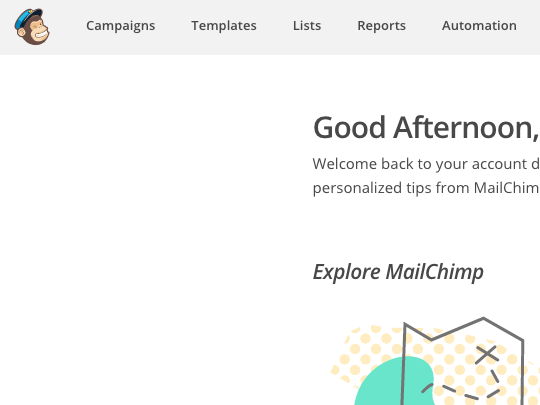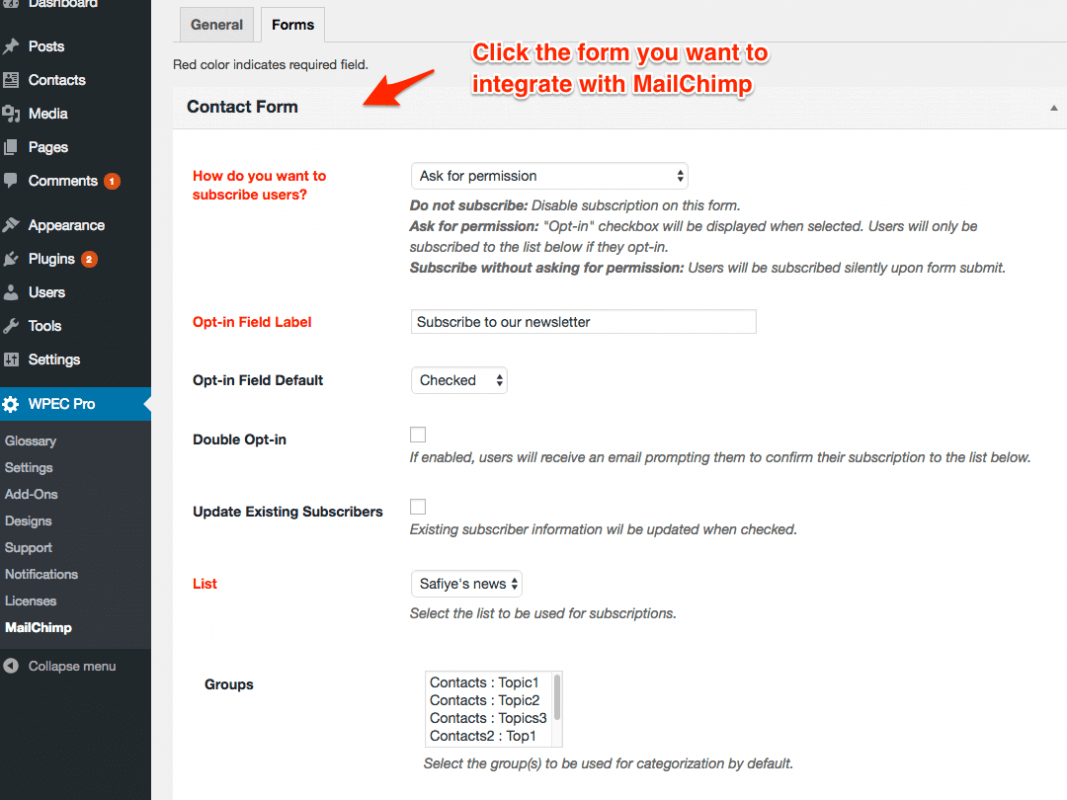In this article, I would like to share some of our findings we discovered during the design and development of eMD MailChimp extension and WP App Studio MailChimp connection focusing on the definitions of some MailChimp campaign related concepts such as lists, groups and segments etc.
MailChimp is one of the prominent email marketing platforms offering email campaign template creation, advanced list management and segmentation capabilities among many other things to improve your overall email campaign effectiveness. As you may already know, email marketing is "the king of the marketing" with a 4400% ROI and $44 for every $1 spent.
First things first
To be able send an email campaign using MailChimp, you must have an account. So go ahead an create one in mailchimp.com if you do not have one already. After logging in, you will see the screen below:
 |
Let's define the menu items first;
There is an extensive knowledge base on each menu item if you'd like to drill down and learn more. I will try to explain Lists related concepts. |
MailChimp Lists
A MailChimp lists consists of email addresses to be used in your email campaigns. To be able to send emails using MailChimp, you need to have at least one list. You should be very careful about creating lists since MailChimp charges based on the number of emails in your lists. As a rule of thumb, you should create a separate list if you have information that includes;
- Different types of attributes (merge tags) not applicable to your master list. For example, if your master list is about employee information such as department, salary, office number etc. and the other list has the attendee information on your latest trade show such product preferences, location the data collected etc. , go ahead and create one. So the contact type should be significantly different.
- Temporary, one time only, seasonal collection of email addresses that you do not want to merge to your master list
So think about consolidation of information when it comes to MailChimp list creation. How about if want to send emails to certain people within your list? This is the point where MailChimp Groups and Segments come in.
MailChimp Groups and Segments
Segmentation is an email marketing technique to categorize and tag emails based on some criteria to make sure your audience gets relevant and useful information. If the information you send to subscribers do not fall into the relevant and useful information either it is considered spam or a reason to unsubscribe.
Unsubscribing part is totally fine. If you do not need to see a particular email content on your inbox for whatever reason, you should or ask your audience to unsubscribe. Because the whole idea behind sending someone an email is to provide information and trigger some kind of action on his or her part. If your email does not meet the criteria, it is waste of your and email provider's resources. Email providers do not like their resources to be abused so they fight back by spam filtering your email and worse blacklisting your domain, ip etc.
MailChimp Groups
MailChimp helps you better reach to your audience by offering groups and segments. A MailChimp group is used for categorization of your email list. In many content management systems (CMS), including WordPress, this concept is called taxonomy. Like CMS what taxonomies do for you, MailChimp groups help group, categorize or cluster your email list based on one to many values or variables. This helps you better understand the data in your list and better target your audience with relevant and useful content.
MailChimp Segments
Segmentation is the act of filtering your data for a specific purpose. Segment, on the other hand, is a subset of your email list which is used to target a specific audience. You can promote MailChimp segments to groups if the segment is significant enough and contain subsegments that can be targeted based on some type of shared data.
Unlike other proprietary, in-house systems I used in the past, MailChimp only allows up to 5 conditions which could be fine for most purposes. However, if you need more complex segmentation, you should consider premassaging your data by flagging certain events, behaviours etc. to make it easy for yourself. Using a data mining tool is very helpful and recommended if you are really into getting the most out of your lists.
MailChimp categorizes segments as dynamic and static. Dynamic segments are the ones where the list data changes over time due to additions, deletions and/or updates. Static segments are for non-changing data such as event attendee lists or trade show sign-up lists.
List Hygiene
Let's recognize the fact people lose interest in what we offer, move to another company, change their email addresses etc. So as an email sender, you start to get no engagement, soft or hard bounces each time you send an email campaign to your aging list. So every email list has an expiration date. Closer you get to that date, less juice you get out of it.
List hygiene is a term used for updating, removing contacts not responding your content. Sending emails to a contact who stopped engagement with your content is not a better use of your resources. Remember MailChimp charges based on the number of contacts in your list. So if someone is not responding to your content for whatever reason is costing you money which can be better spent elsewhere.
Fortunately, MailChimp offers pre-built segments. A pre-built segment is "an automatically generated segment based on list information or subscriber activity". Pre-built segments are categorized in three categories:
- Subscriber Engagement
- Customer Behavior
- Demographics
The inactive subscribers segment of the pre-built subscriber engagement category could be very useful for cleaning up your list. Inactive subscribers are subscribers who did not open any of your last five campaigns. So start cleaning up your list from there may help getting better results out of your campaigns. There is good, well -organized information on pre-built segments in MailChimp the knowledge base.
Business case for eMD MailChimp WordPress plugin
Based on what we have covered so far there are two important points to consider in our product design:
- Data must go through some business rules before getting routed to MailChimp groups
- Data structures can be different in WordPress side than MailChimp side
eMD MailChimp extension was build on these important needs in mind.
Here is our product description as a result: eMD MailChimp extension integrates the forms included in our plugins to MailChimp for email list building offering extensive grouping functionality for better segmentation. For example, in WP Easy Contact WordPress plugin, eMD MailChimp extension can be used to target leads through email campaigns.
How eMD MailChimp plugin can help you

eMD MailChimp extension offers powerful grouping functionality for advanced segmentation. You can assign form submissions to one to many MailChimp groups by default.
Alternatively, using advanced grouping feature, you can create unlimited number of group mappings using one to many taxonomy values to assign incoming contacts to MailChimp group(s). This will help you create more complex segmentation schemes than MailChimp's maximum 5 conditions. Simply, tag a subscriber meeting certain criteria and create a mapping to assign the subscriber to a specific segment. Think of this as your first steps for scoring your leads before offering them specific products or services.
If you need more advanced segmentation schemes, you can always export your list to CSV, analyze and group your data using a data mining tool and import it back to WordPress with improved tagging. Most of our plugins come with integrated utility for importing/exporting/updating data from/ to CSV. For the plugins that do not come with this utility, you can purchase eMD Import Export WordPress plugin. Very handy and extremely cost-effective way to handle data driven segmentation.


MailChimp merge tags are used to personalize your campaigns with contact names, social media buttons, blog post etc. Every MailChimp list comes with pre-built merge tags such as first name, last name, email etc. You can create custom merge tags during list creation or using list settings > "List fields and *|MERGE|* tags" menu item.
MailChimp Merge tags can be mapped to the available form fields of your plugin including WordPress custom fields. This feature helps you use your own categorizations, tags and fields for segmentation for targeted campaigns. Take a look at the plugin page or watch the introduction video to find out if eMD MailChimp plugin helps you become better MailChimp email campaigner.





